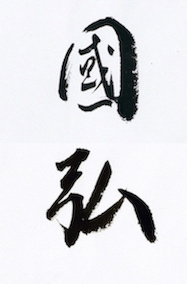
The name of Kunihiro (國弘) looks like a mystery name among all other of the Sagami School’s ancestors. Kunihiro (國弘) played its important part in the formation and development of the Sōshū-Den. Despite of the fact that there is no information about his preserved works now, nevertheless, the role of this master is very important in the history of the Sagami school. The name of the smith used to write his own name applying the «hiro» (弘) kanji in such a transcription and whose activity period falls in the middle of the Kamakura period (1185–1333) is found in many old manuscripts. It is still unknown the master’s originally school and what was his own forging style, however, it is very likely that he was one of those masters who developed the techniques of his former school, adding a new elements of a new emerging Sōshū-Den style. Thus, Kunihiro (國弘) probably was working together with Shintōgo Kunimitsu and was a little older than Kunimitsu.
One of the versions of the Kunihiro’s origin is presented in Koto Meizukushi Taizen (古刀銘盡大全), while a swordsmith with that name is presented in two genealogy lines at once. The genealogy of the Awataguchi School contains the following information about the three disciples of Awataguchi Kunitsuna (粟田口国綱):
- Norikiyo (則清) - a disciple of Kunitsuna; was active around the Kōan era (弘安, 1278-1288).
- Kunihiro (國弘) - a disciple of Kunitsuna; he was living in Kashū (加州) province later; was active around the Gennin era (元仁, 1224-1225).
- Sanekuni (真國) - a disciple of Kunitsuna; was living in Sōshū around the times of the Kōan era (弘安, 1278-1288); he was applying the name Kunitsuna for signing his own works; second generation of Kunitsuna.
Thus, from this disciples list, we get two very important reference dates: the Kōan era (弘 安, 1278-1288) as a period of the creative activity of Kunitsuna's students and the Gennin era (元 仁, 1224-1225) as a note for the supposed years when Kunihiro's teaching was begun by Kunitsuna. One can remember the years of life of Kunitsuna himself are indicated as 1163-1335. Considering these dates, we can make an assumption that Awataguchi Kunitsuna started to teach his own students at a fairly mature age.
Figure 1. Genealogy of the Awataguchi School's masters. Kotō Meizukushi Taizen, 1792, vol. 2, p. 1/2 and 2/1.
Another mention of a swordsmith using the name Kunihiro (國弘) can be found in the Tōgenji-Ichimonji (藤源治一文字) lineage where he was listed among Sukezane’s disciples in the same manuscript:
- Sukesada (助貞) - a disciple of Sukezane, came from Bizen province, born in the 1st year of the Karoku era (嘉禄, 1225) and died in the 3rd year of the Kōan era (弘安, 1280) in the 56th year of his life;
- Suketsuna (助綱) - a disciple of Sukezane, born in the 1st year of the Bun ́ei era (文永, 1264) and died in the 3rd year of the Shōwa era (正和, 1314) in the 51st year of his life;
- Yoshimoto (吉元) - a disciple of Sukezane, grandson of Bizen Yoshifusa (吉房), Magotarō (孫太郎), born in the 3rd year of the Bun ́ei era (文永, 1266) and died in the 2nd year of the Tokuji era (徳治, 1307) in the 42nd year of his life;
- Kunihiro (國弘) - a disciple of Sukezane, he signed at the beginning of his career as Kunihiro (國廣), borne the first name Tōgenji Dayū (藤源治太夫), born in the 8th of the Bun ́ei era (文永, 1271) and died in the 2nd year of the Shōchū era (正中, 1325) in the 55th year of his life, it is said that he was working in Hyūga (日向) province also.
[Kunisuke (国助) - a son of Kunihiro; he was born in the 6th year of the Einin (永仁, 1298) and died in the 4th year of the Shōkyō era (正慶, 1335) in the 38th year of his life]
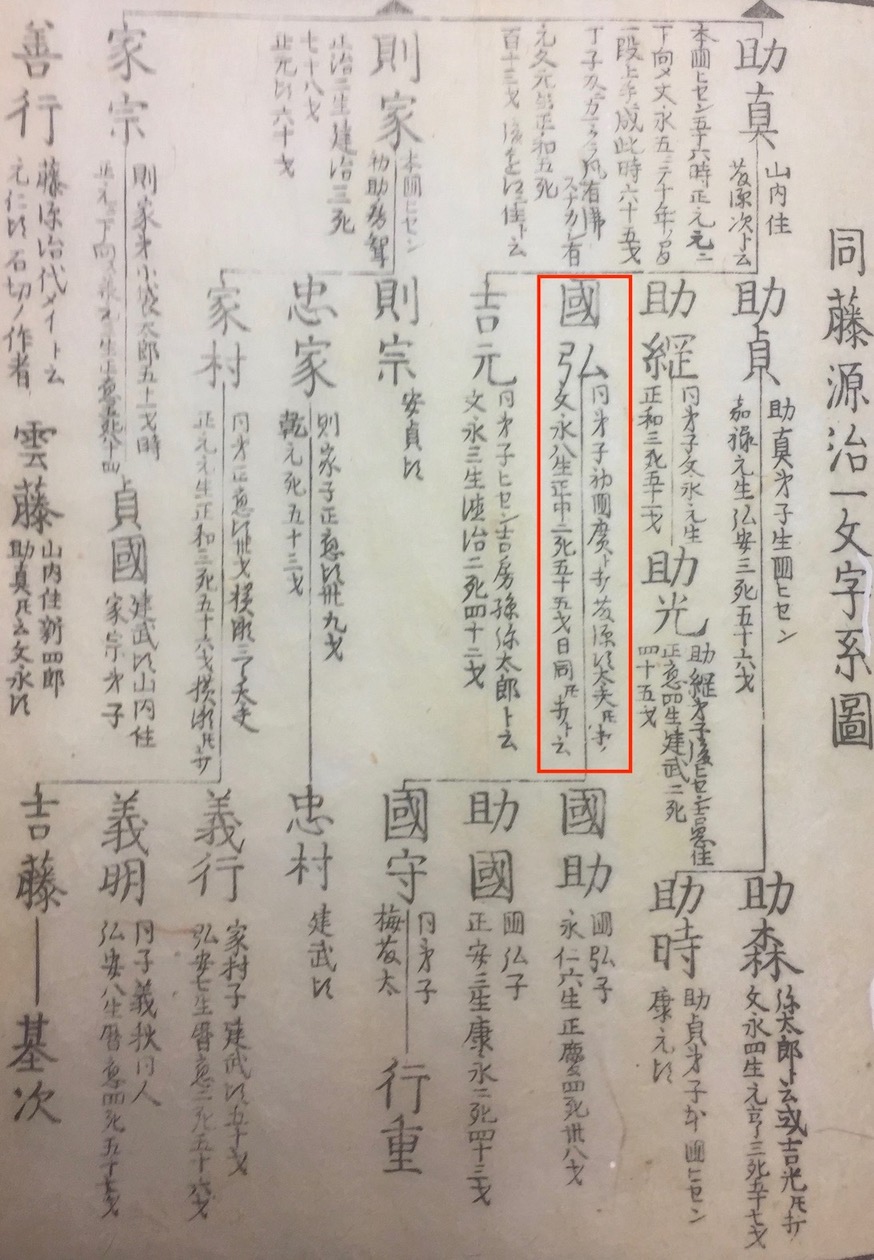
Figure 2. Genealogy of the Tōgenji-Ichimonji School's masters. Kotō Meizukushi Taizen, 1792, vol. 2, p. 13/1.
Kunihiro as a son of Sukezane in old manuscripts described by follow: he was named Kunihiro and borne first name Togenji. According to one theory, he died in the middle of the second year of the Shōchū era (正中, 1324-1326) (1325) and went to 55 years. His swords are similar to Sukezane, but the sugata is weaker, and there is gentle figure that became to the cutting edge, ko-kissaki, hamon is ko-choji-midare and is differ from that by Sukezane. It is possible to see the one of the distinctive characteristics of the Fukuoka School, that is, midare-utsuri. The distinguishing point of Fukuoka Ichimonji is that it has a solid texture that is solid and tight with a like-sky-grained surface. Itame hada.
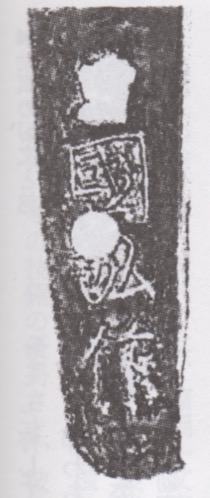
Figure 3. Kunihiro's signature example.
In addition, Sukezane never made tantō, and Kunihiro made them but with sugata that remind of the works of the early period of Sōshū, and with nie structures different from that of Bizen ko-chōji-midare, and in a wide mihaba similar to the later period Sōshū.
Therefore, alternative version of the Kunihiro’s origins is coexists in the same manuscript together with a main version. It is possible that we are talking about the same swordsmith, but, more likely, these are still two different masters. It is unlikely that it was the same master, since the indicated dates of life and the schools in which these masters studied, were very different. Due to the fact that Awataguchi School is closest to the style of Shintōgo Kunimitsu, the master who worked with Shintōgo in developing of the Sōshū-Den is more likely to had a connection with the Awataguchi smiths mainline.
Even more interesting is the part of the genealogy related to Kunihiro, which can be found in the Kokon Meizukushi Taizen (古今銘尽大全).
Figure 4. Kokon Meizukushi Taizen by Takeya, 1661, vol. 1, p. 2/1.
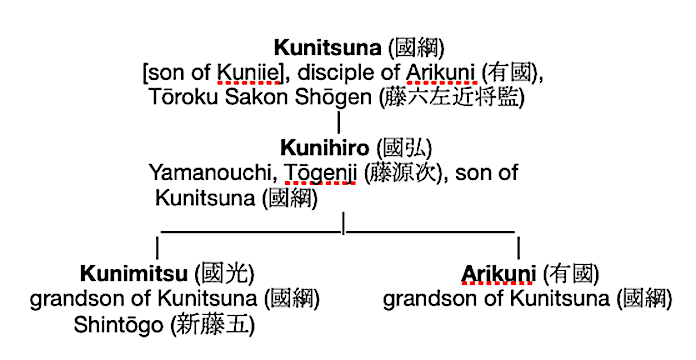
Particular attention must be paid to the genealogy presented in one of the most important and oldest manuscripts. Kanchi-in Bon Mei Zukushi (観智院本銘尽) was based on the records made from 1299 to 1316; that is, in the period when the masters of the Sagami School, who are mentioned in that book, were still alive.
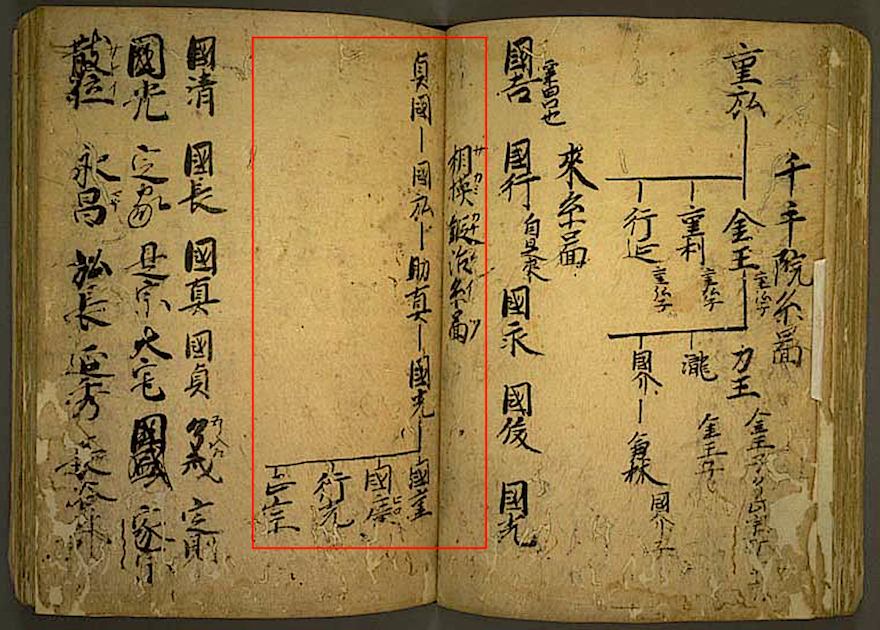
Figure 5. Kanchi-in Bon Mei Zukushi, the two-page opening No. 22.
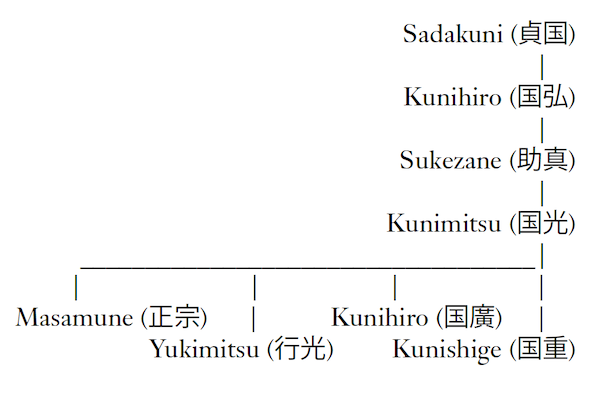
There, we should pay attention to two very interesting facts. First, in this book the genealogical line begins with Sadakuni, although, most likely, it meant Sanekuni (眞國). This inaccuracy could be due to very similar writing of the old form of the kanji “Sane” (眞, the old and unabbreviated form of 真) and “Sada” (貞). According to old sources, Uchida Soten (内田疎天, 1871–1952) calls Sanekuni a disciple of Awataguchi Kunitsuna, who came to the area of Yamanouchi in Kamakura, changed his name, and signed as “Yamanouchi-jū Kunitsuna.” However, Uchida Soten doubts that Awataguchi Kunitsuna himself had ever worked in Kamakura. Another interesting fact about this version of the genealogy is that it presents Shintōgo as an heir, a representative in a straight line of succession after Kunihiro and Sukezane. This may be evidence of Sukezane’s personal involvement in creating the Sagami School’s smithing tradition.
Kanchi’in Bon Mei Zukushi (観智院本銘尽) in addition to Sagami genealogy contains the followed variant so-called Kunimune line:
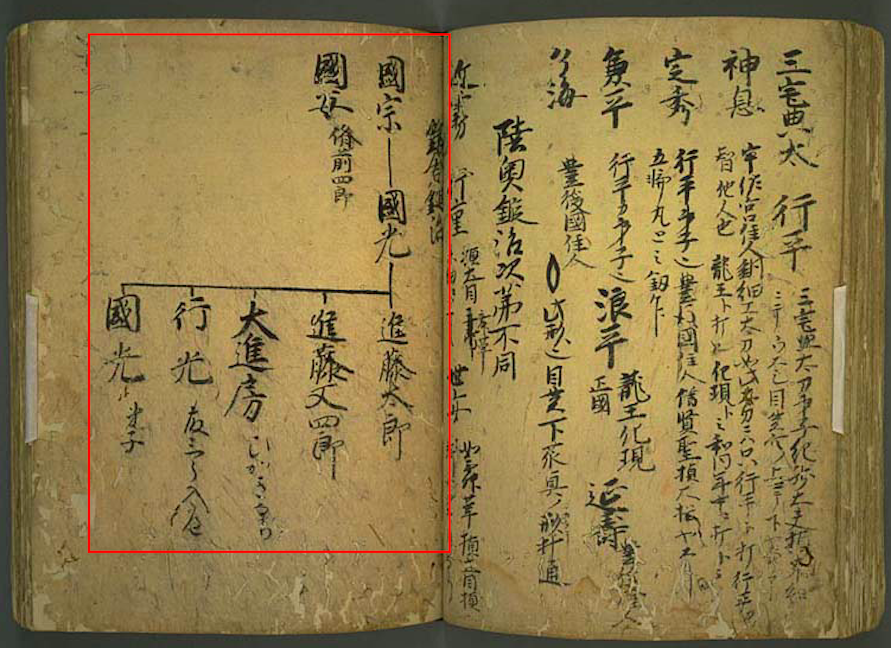
Figure 6. Kanchi-in Bon Mei Zukushi, the two-page opening No. 26.

It could be considered as very important source of information that is not studied with appropriate attention. Paying attention on this genealogy line we can see two names in the Kunimitsu line: Shindō Matashirō and Shindō Tarō. Reading the mei inscription 進藤 as Shintō it is necessary to indicate that there are also experts who consider this to be the family name of Kunimitsu (國光).
Honchō Kaji Kō (本朝鍛冶考—1795, by Kamata Natae) describes Awataguchi Kunitsuna and Kunihiro as followed:
Kunitsuna (國綱): during the times of reign of Emperor Juntoku (順徳, i.e. from 1210 through 1221) and Kenpō era (建保, 1213-1219); a sixth son of Kuniie, Tōrokurō, he borne the honorary title Sakon Shōgen; made Onimaru (鬼丸) masterpiece; he was living in Kamakura.
Kunihiro (國弘): during the times of reign of Emperor Shijō (四条, i.e. from 1232 through 1242); during the eras Tenpuku (天福, 1233-1234) and Katei (嘉禎, 1235-1238); son of Kunitsuna, was living in Yamanouchi, his birth name was Tōgenji, he was living in Kaga province later, also signed as Kunitsuna (國綱).
A very detailed study regarding one of the most mysterious masters in the history of the Sagami school: Kunihiro, can be found in the Dai Nihon Tōken Shinkō (大日本刀劍新考) by Uchida Soten (内田疎天), 1939. This book contains two genealogy lines that mention Kunihiro. The first one is related to the so-called Kunimune line of the Sagami School and the part devoted to Kunitsuna and Kunihiro looks as follow:
Kunitsuna (國綱): He came from Awataguchi, clan Hayashi (林氏), first name Tōrokurō (藤六郎), he has also name/title Tōroku Sakon Shōgen (藤六左近将監).
Kunihiro (國弘): son of Kunitsuna, also signed his name as Kunihiro (國廣), also known as father of Shintōgo Kunimitsu (新藤五國光), it is said that he belonged Sukezane mainline, he signed as Kunishige (國重) in early ages.
The same book presents another shortened genealogy. It is describe the six Awataguchi brothers. Only one reference date is given in the Awataguchi brothers’ genealogy line - for Kunitomo (國友). It is indicated that its activity belongs to the period around the Shōji era (正治, 1199-1201) and it is understood that the period for creative activity of the other brothers occurred approximately at the same time period. Regarding Kunihiro, there is the following entry: Kunitsun’s son, activity around the Jōō era (貞應, 1222-1224).
Accordingly to traditional point of view, Awataguchi Kunitsuna, Saburō Kunimune and Ichimonji Sukezane came to Kamakura and laid the foundations of the Sōshū Tradition. However, this is too simplistic point of view and the existence of Kunihiro in many genealogical lines suggests that reality was many times more complicated. There exist old manuscripts from the Tenshō era (天正, 1573-1592) which state that the Kamakura swordsmiths started with Shintōgo Kunimitsu whilst some early period documents claim that Kunimune was the ancestor of the local Kamakura smiths (see the genealogy in the Kanchi’in Bon Mei Zukushi). According to old books, Awataguchi Kunitsuna and Bizen Saburô Kunimune came around Shōji era (正治,1199-1201) to Kamakura where they laid the foundation for the Sōshū tradition and Kunimune was twenty years old at that time. There was a Kunitsuna who lived in Yamanouchi (山内) area of Kamakura.
However, there are doubts that Awataguchi Kunitsuna himself had ever worked in Kamakura. He was staying in Kyōto. Apart from that, there are old manuscripts which say that it was Awataguchi Kunitsuna’s student Sanekuni (真國) who went to Kamakura where he changed his name and started signs as Yamanouchi-jū Kunitsuna. This is supported by a genealogy found in the Kanchi’in Bon Mei Zukushi that was compiled when some of these Kamakura swordsmiths were still active. In the «Kunimune» genealogy, Kunihiro is listed as succeeding Awataguchi Kunitsuna but in early books Sagami genealogy, he is listed as the son of Sanekuni who had succeeded as second generation Kunitsuna and moved to Yamanouchi in Kamakura. As he was a distinguished smith from a very famous lineage of sword making, his works were probably mistaken for those of his Kyōto lived predecessor Awataguchi Kunitsuna and this might be the reason for the emergence of the tradition that Awataguchi Kunitsuna was one of the ancestors of the Kamakura swordsmiths.
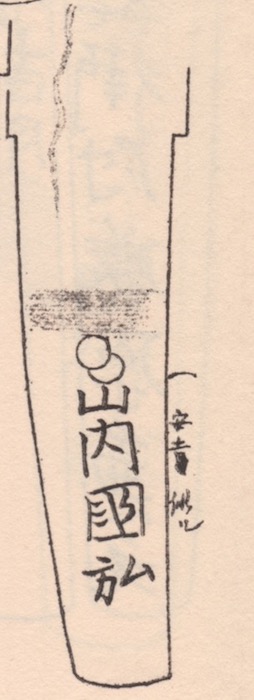
Figure 7. Kōzan Oshigata (光山押形), 1967, Volume 2, p. 17/2.
Probably, the school of Kunitsuna was rivalling that of Kunimune and although it was surely living up to its famous name, Kunitsuna was probably outnumbered by the Kunimune School in terms of students it trained and was thus Kunitsuna continuing an existence as a local sideline of Kamakura smiths.
Unfortunately, there are neither surviving works signed by Kunihiro, nor an osigata with a confirmed signature by the master that was working in Kamakura during the period from 1230 through 1250 years. Undoubtedly, we cannot ignore the existence of a unique oshigata in the Oseki Shō (往昔抄, originally published in 1519). This tantō is not dated and there is no any entry which could help us to fix activity period of swordsmith was mentioned in oshigata. According to the presented information, there were three generations of the smith with this name, Hatsu, lived in Numa (沼間) Sagami province, first name Tōgenji Dayū (藤源次太夫).
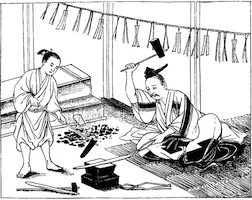
In addition there is only one known mention of Kunihiro’s workmanship, one can found in the Shinkan Hiden Shō (新刊秘伝抄, 1573–1592) described his hardening, amongst others: notareba and hoso-suguha and pointed bōshi with a relatively long kaeri.
It is quietly different compared with information presented in Albert Yamanaka’s Nihontō Newsletter (Volume 1, p. 140). The main characteristic features of Kunihiro (國弘 - student of Sukezane) works described as followed:
Sugata: The tachi style is typical for the mid Kamakura period with a shallow sori, the shinogi is made a little bit high.
Kitae: The steel will seem a little «weak», the grain is made in form of ō-mokume hada mixed with masame hada.
Hamon: The hamon line is made in form of ko-chōji-midare and mixed together with a little nie.
Bōshi: Is made in form of midarekomi with a slight kaeri.
Horimono: Bo-hi and futasuji-hi are rarely seen.
Nakago: The nakago is made a little short with tip in form of kurijiri, yasurime is kiri, signature is made in form of niji-mei.
It is necessary to pay attention to the Kinihiro’s first name, mentioned in Oseki Shō. This is a very rare name and probably it could be referred to Sukezane (whose first name was Tōgenji) or smiths mentioned in meikan and was active in the Hōgen era (保元, 1156-1159) in the Sagami province: Kunihiro (国弘) and Tōgenji (藤源次). It is also possible that these entries go back to an earlier Sagami-based smith with the same names or to the Mōgusa group (舞草), that was working also in the Sawama (沢間) of the Sagami ́s Miura (三浦) district. For example, on of the Mogusa group smith was mentioned in meikan as: Takishirō (瀧四郎), was active in the Hōgen era (保元, 1156-1159); lived in Sagami; was signed as Yamanouchi Takishirō Tayū saku (山内瀧四郎大夫作); borne first name Takishirō Tayū“ (瀧四郎大夫); it is said that he came originally from Ōshū (奥州) and belonged there to the Mōgusa group (舞草).

Figure 8. Ōseki Shō (往昔抄), reprint edition 1978, p. 27.
The close relationship of the Sagami and Mōgusa schools ancestors has to be seriously studied and there are very serious reasons to believe that the blacksmiths of the Mogus School, who historically always had a residence in the Sagami province, took part in laying the foundations of Sōshū-Den.
It is quite possible that Kinihiro’s works exist in our time in an unsigned form, possessing many essential characteristic features of the Sagami School and attributed to another swordsmiths of Awataguchi or even Sōshū-Den. Unfortunately, it is not possible to restore the line of Kunihiro (國弘) exactly, although it is very simply to construct one or another variant of a three generations genealogy based on the information presented above. However, for better understanding all particularities of emerging and forming Sagami School it is enough to know that Kunihiro (國弘) was among of the swordsmith working together with Shintōgo Kunimitsu founding the basis for Sōshū-Den.
Original content Copyright © 2020 Dmitry Pechalov